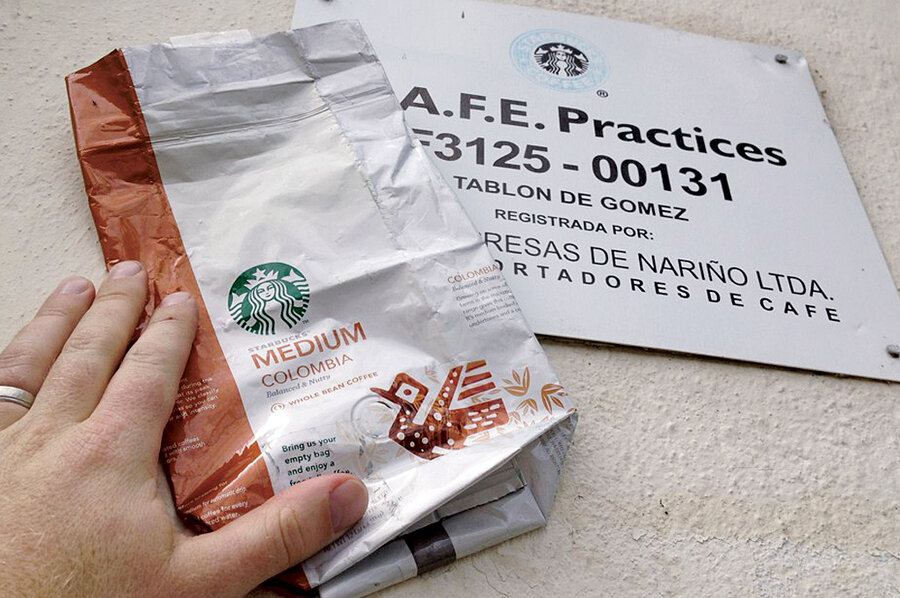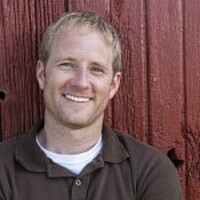Follow your labels: Starbucks coffee farmers who never heard of Starbucks
Loading...
| EL TABLóN DE GOMEZ, Colombia
"How far do we go for a better cup of Colombian coffee?" Starbucks asks on its website. "Six thousand feet – straight up. Sounds extreme, we know. But high atop the majestic Andes, in a rugged landscape of simmering volcanoes, is where the finest coffee beans in Colombia like to grow."
Not only did I want to drink this coffee after reading that narrative, I wanted to visit. I wanted to meet the people who grow my coffee. So in the spring of 2012, I contacted the Starbucks public relations and customer service departments repeatedly, telling them I was working on a book about the global food economy and asking them to point me in the right direction. I finally received an answer from a customer service agent: "Unfortunately, the information you are requesting is proprietary."
So I went to Colombia and found the farmers on my own. Starbucks was right; it was extreme. High atop the majestic Andes in a rugged landscape of simmering volcanoes, I straddled a coffee tree as if it were a fireman's pole and hung on for dear life. The shivering trunk was the only thing keeping me from falling thousands of feet down the volcanic slope.
Meanwhile, Felipe Ordonez, a Colombian coffee farmer who tends 4,000 trees near the village of El Tablón de Gomez stood in the loose volcanic soil as if he were watching grass grow, probably questioning his decision to hire me as a coffee worker for the day.
When Starbucks wouldn't help me, I had acted on the only information I had to go on – the Starbucks 2011 C.A.F.E. (Coffee and Farmer Equity) Practices report in Nariño, Colombia. C.A.F.E. Practices is what Starbucks points to when customers ask why it doesn't buy more Fair Trade coffee. In 2010, the company reported that 8 percent of its coffee was Fair Trade Certified. A certification is granted by third-party certifiers such as Fair Trade USA or Fairtrade International based on several principles: a set minimum price, a fair-trade premium that goes directly back to the producers, supply-chain transparency, and specific environmental and social standards. It is Starbucks's own set standards, but the company doesn't set minimum prices, or pay farmers anything resembling a "fair trade premium." The company launched its C.A.F.E. Practices in 2003, and by 2010 it said it was purchasing 86 percent of its coffee from certified farms.
The Starbucks report says there are 22,000 farms in Nariño participating in its program. Yet when I first asked around, no one had heard of Starbucks or recognized its siren logo. Then I caught a glimpse of the faded siren atop a white plaque high on the side of a home here. "C.A.F.E. Practices" was printed below the logo.
I posed for a photo with my coffee bag and the sign. An old woman with butterfly earrings walked out and asked me what I was doing, as one is apt to do when a stranger poses for a picture with your home. I showed her my bag of Starbucks Colombian roast, pointed to the sign, and explained my mission.
"I have no idea what that sign is," said the woman, who owns a small coffee farm. And she began a rant about how no one helps her. "I've never heard of Starbucks."
Once I had an eye for the plaque, I saw it on home after home. I would point to the Starbucks C.A.F.E. Practices sign on the farmers' homes and find that many of them had never heard of Starbucks. The ones who had would say things like: "We were promised Starbucks was going to help us years ago. We're still waiting."
To be sure, some of the farmers had heard of Starbucks and had received assistance.
Mr. Ordonez, who agreed to let me molest his coffee trees, appreciated the technical assistance provided to him. Other farmers had even received coffee washing machines known as beneficios.
When Dub Hay, Starbucks senior vice present of global coffee procurement, came to the defense of C.A.F.E. Practices following a negative story on the program in Ethiopia in 2007, he responded: "You go to Nariño, Colombia. We built 1,800 [coffee] washing stations and sanitation facilities and homes.... It's literally changed the face of that whole area.... The same is true throughout Latin America. They call it the Starbucks effect."
No one I met called it the Starbucks effect. Even the farmers who sell knowingly to Starbucks and those who had received assistance prefer to get their beans certified by and sold to Nespresso, which pays 28 cents more per kilogram.
The consensus in this area is that not much has happened with the C.A.F.E. Practices program in the past seven years; but while the program appears to be missing on the ground, it is very present on the company's website, in marketing copy, and in any discussion about its corporate responsibility.
After I visited the farmers of Nariño, I talked with several officials of the region's coffee industry who confirmed the absence of Starbucks. A representative of the Colombia Coffee Growers Federation told me that all Starbucks does is buy coffee. I even met a technician who had hung some of the C.A.F.E. Practices signs but wasn't surprised that the farmers I met had never heard of Starbucks: "Certifications is a business for most people. You can sell more coffee if you have a particular logo."
I reached out to Starbucks after my visit here, and still haven't received a response. The silence, like their marketing copy, does little to enlighten consumers about the reality of the coffee farmers' lives.








